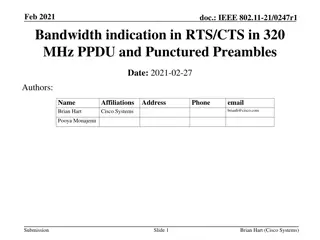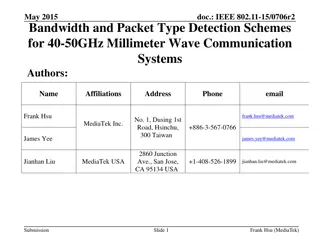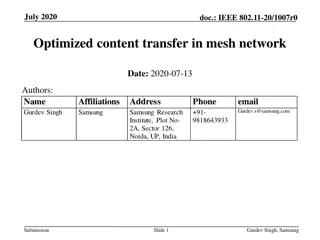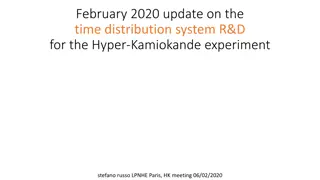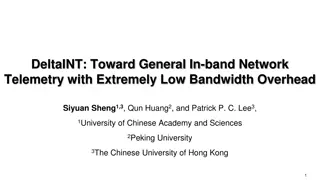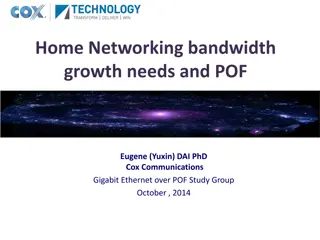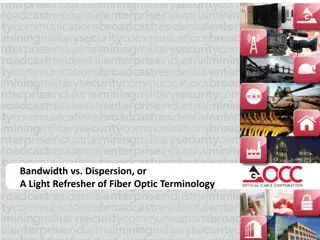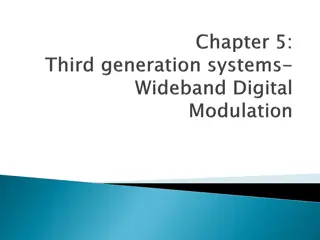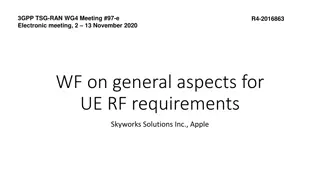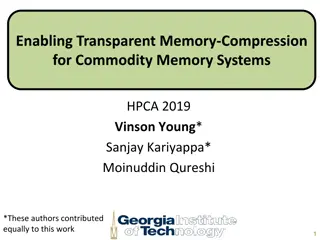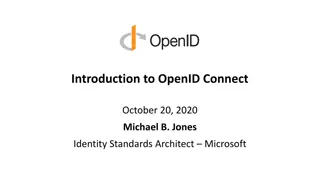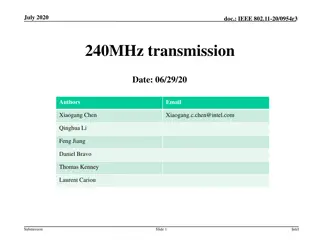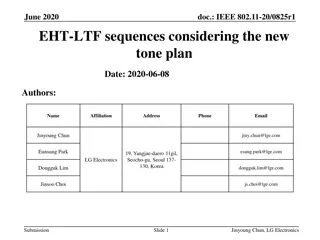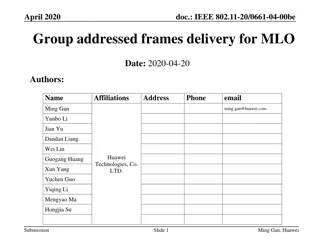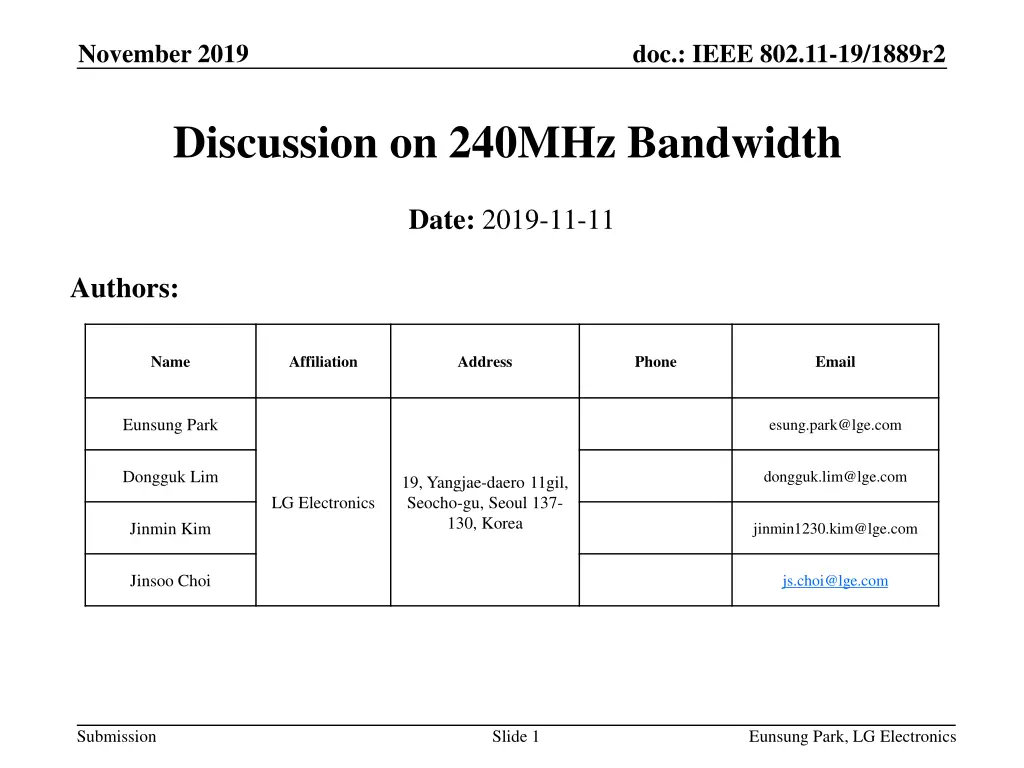
Discussion on 240MHz Bandwidth Proposal
Explore the proposal for IEEE 802.11-19/1889r2 supporting 240/160+80 MHz transmission in the November 2019 document. The discussion focuses on the benefits of utilizing 240/160+80 MHz bandwidth for improved throughput and efficiency, presenting a tone plan and bandwidth indication method. Discover how implementing this proposed bandwidth mode in 11be can enhance performance and efficiency compared to traditional 320/160+160 MHz usage.
Download Presentation

Please find below an Image/Link to download the presentation.
The content on the website is provided AS IS for your information and personal use only. It may not be sold, licensed, or shared on other websites without obtaining consent from the author. If you encounter any issues during the download, it is possible that the publisher has removed the file from their server.
You are allowed to download the files provided on this website for personal or commercial use, subject to the condition that they are used lawfully. All files are the property of their respective owners.
The content on the website is provided AS IS for your information and personal use only. It may not be sold, licensed, or shared on other websites without obtaining consent from the author.
E N D
Presentation Transcript
November 2019 doc.: IEEE 802.11-19/1889r2 Discussion on 240MHz Bandwidth Date: 2019-11-11 Authors: Name Affiliation Address Phone Email Eunsung Park esung.park@lge.com Dongguk Lim dongguk.lim@lge.com 19, Yangjae-daero 11gil, Seocho-gu, Seoul 137- 130, Korea LG Electronics Jinmin Kim jinmin1230.kim@lge.com Jinsoo Choi js.choi@lge.com Submission Slide 1 Eunsung Park, LG Electronics
November 2019 doc.: IEEE 802.11-19/1889r2 Introduction In the September F2F meeting, TGbe decided to support 320 / 160+160 MHz In this contribution, we propose that 11be supports 240 / 160+80 MHz transmission In addition, we discuss a tone plan and a bandwidth indication method for 240 / 160+80 MHz Submission Slide 2 Eunsung Park, LG Electronics
November 2019 doc.: IEEE 802.11-19/1889r2 240 / 160+80 MHz Bandwidth 240 / 160+80 MHz Bandwidth would be helpful to improve average throughput and efficiency If a certain 80MHz channel within 320 / 160+160 MHz bandwidth is busy due to an OBSS transmission, it is better to use 240 / 160+80 MHz bandwidth than to use only 80 / 160 MHz bandwidth for a PPDU transmission Exploiting these two types of bandwidth modes (240/160+80 MHz, 320/160+160 MHz) can provide better throughput (maximum 12% gain) and efficiency compared to using only the 320/160+160 MHz bandwidth [1][2] We propose to support 240 / 160+80 MHz bandwidth in 11be which is constructed from three 80MHz channels including primary 80MHz 240 / 160+80 MHz can be formed by 80MHz preamble puncturing in the 320 / 160+160 MHz bandwidth Submission Slide 3 Eunsung Park, LG Electronics
November 2019 doc.: IEEE 802.11-19/1889r2 Tone Plan Tone plan of 240 / 160+80 MHz can be determined based on that of 320 / 160+160 MHz if we consider 80MHz preamble puncturing For example, if 2x2020-tone RU based tone plan [3] is used for 320 / 160+160 MHz, the tone plan of 240 / 160+80 MHz can be composed of 2020-tone RU and 996-tone RU based structure 2020-tone RU 996-tone RU 5 null tones 5 null tones 11 right guard 23 null tones 12 left guard For a simple implementation, 11ax 80MHz tone plan can be repeated three times for both OFDMA and non-OFMDA tone plans of 240/160+80 MHz regardless of the 320 / 160+160 MHz tone plan 996-tone RU 996-tone RU 996-tone RU 5 null tones 5 DC 5 null tones 11 right guard 23 null tones 23 null tones 12 left guard Submission Slide 4 Eunsung Park, LG Electronics
November 2019 doc.: IEEE 802.11-19/1889r2 Bandwidth Indication (1/2) Similar to the 11ax PPDUs, TGbe can consider various PPDU types, for example, EHT SU PPDU for SU transmission using an entire bandwidth, i.e., 20/40/80/160/80+80/240/160+80/320/160+160 MHz EHT OFDMA PPDU for MU transmission and SU transmission with multiple RU allocation based on preamble puncturing as well (Separate PPDUs can be defined for MU and SU transmission) EHT ER SU PPDU, EHT TB PPDU, etc. PPDU names can be changed 80MHz preamble puncturing can be considered in EHT SU PPDU to form 240/160+80 MHz while any kind of preamble puncturing (e.g., 20MHz preamble puncturing) can be applied to EHT OFDMA PPDU to enhance efficiency We consider that EHT SU PPDU doesn t have a field like HE-SIG-B, and thus, exact puncturing patterns need to be indicated in a Bandwidth field Slide 5 Submission Eunsung Park, LG Electronics
November 2019 doc.: IEEE 802.11-19/1889r2 Bandwidth Indication (2/2) In EHT SU PPDU, 3 bits may be sufficient to indicate the bandwidth including 240 / 160+80 MHz There are three possible cases for 240 / 160+80 MHz transmission We consider that primary 80MHz is always used when transmitting 240 / 160+80 MHz PPDU To decode the PPDU, receivers need to know which channels are used to transmit the PPDU Exact channel information needs to be indicated in the Bandwidth field if EHT SU PPDU doesn t have a kind of the RU allocation field as in HE-SIG-B Primary 80 Secondary 80 Lower 80 Higher 80 Case 1 Primary 160 Secondary 160 Case 2 Primary 80 Secondary 80 Lower 80 Higher 80 Case 3 Primary 80 Secondary 80 Lower 80 Higher 80 : not used or punctured Then, we can use the following Bandwidth field as an example 0: 20MHz 1: 40MHz 2: 80MHz 3: 160/80+80MHz 7: 320/160+160MHz 4: 240/160+80MHz Case 1 5: 240/160+80MHz Case 2 6: 240/160+80MHz Case 3 For simplicity, we can only consider case 2 or 3 for 240/160+80MHz transmission, i.e., it is possible only if primary 160MHz is idle Slide 6 Submission Eunsung Park, LG Electronics
November 2019 doc.: IEEE 802.11-19/1889r2 Summary We have proposed that 11be supports 240 / 160+80 MHz transmission Its tone plan and bandwidth indication method have been discussed Submission Slide 7 Eunsung Park, LG Electronics
November 2019 doc.: IEEE 802.11-19/1889r2 Straw Poll #1 Do you agree to add the following text to the TGbe SFD? 11be supports 240 MHz and 160+80 MHz transmission 240 / 160+80 MHz bandwidth is constructed from three 80MHz channels which include primary 80MHz Y/N/A : 24/0/19 Submission Slide 8 Eunsung Park, LG Electronics
November 2019 doc.: IEEE 802.11-19/1889r2 Motion #1 Move to add the following text to the TGbe SFD 240 / 160+80 MHz bandwidth is constructed from three 80MHz channels which include primary 80MHz Moved by: Eunsung Park Second: Y/N/A : Submission Slide 9 Eunsung Park, LG Electronics
November 2019 doc.: IEEE 802.11-19/1889r2 Straw Poll #2 Do you agree to add the following text to the TGbe SFD? For the tone plan of 240MHz and 160+80MHz, 11ax 80MHz tone plan is repeated three times Y/N/A : // Submission Slide 10 Eunsung Park, LG Electronics
November 2019 doc.: IEEE 802.11-19/1889r2 Straw Poll #3 Do you agree to add the following text to the TGbe SFD? 11be supports EHT SU PPDU EHT SU PPDU is used for the DL/UL SU transmission using an RU which size corresponds to the bandwidth indicated in the Bandwidth field in a EHT-SIG field The bandwidth indicated in the Bandwidth field can be one of 20MHz, 40MHz, 80MHz, 160/80+80MHz, 240/160+80MHz, 320/160+160MHz, etc. Format is TBD Note: PPDU name can be changed Y/N/A : // Submission Slide 11 Eunsung Park, LG Electronics
November 2019 doc.: IEEE 802.11-19/1889r2 Straw Poll #4 Do you agree to add the following text to the TGbe SFD? In EHT SU PPDU, 3 bits are used for the Bandwidth field Y/N/A : // Submission Slide 12 Eunsung Park, LG Electronics
November 2019 doc.: IEEE 802.11-19/1889r2 Straw Poll #5 Do you agree to add the following text to the TGbe SFD? In EHT SU PPDU, the Bandwidth field includes the following description Set to TBD1 for 240/160+80MHz where primary 80MHz, secondary 80MHz, and lower 80MHz in secondary 160MHz are used for transmission Set to TBD2 for 240/160+80MHz where primary 80MHz, secondary 80MHz, and higher 80MHz in secondary 160MHz are used for transmission Set to TBD3 for 240/160+80MHz where primary 80MHz, and lower and higher 80MHz in secondary 160MHz are used for the transmission Note that secondary 160MHz indicates the 160MHz channel other than primary 80MHz and secondary 80MHz in 320/160+160MHz Y/N/A : // Submission Slide 13 Eunsung Park, LG Electronics
November 2019 doc.: IEEE 802.11-19/1889r2 Straw Poll #6 Do you agree to add the following text to the TGbe SFD? In EHT SU PPDU, the Bandwidth field includes the following description Set to TBD1 for 240/160+80MHz where primary 80MHz, secondary 80MHz, and lower 80MHz in secondary 160MHz are used for transmission Set to TBD2 for 240/160+80MHz where primary 80MHz, secondary 80MHz, and higher 80MHz in secondary 160MHz are used for transmission Note that secondary 160MHz indicates the 160MHz channel other than primary 80MHz and secondary 80MHz in 320/160+160MHz Y/N/A : // Submission Slide 14 Eunsung Park, LG Electronics
November 2019 doc.: IEEE 802.11-19/1889r2 References [1] 802.11-19/0778r0 Consideration on 320MHz Bandwidth and 16 Spatial Streams [2] 802.11-19/1066r0 Tone Plan Discussion [3] 802.11-19/1492r0 Non-OFDMA Tone Plan for 320MHz Submission Slide 15 Eunsung Park, LG Electronics

